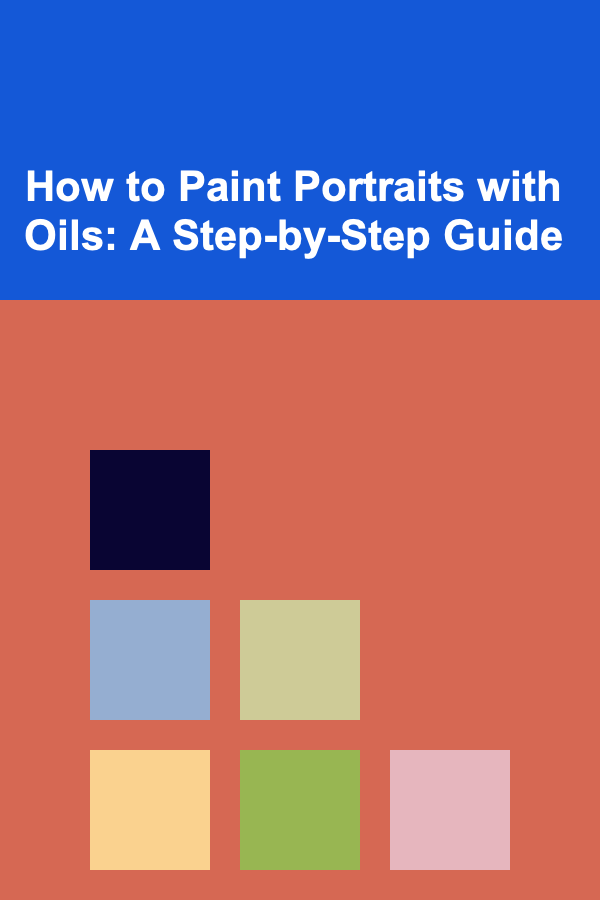
How to Paint Portraits with Oils: A Step-by-Step Guide
ebook include PDF & Audio bundle (Micro Guide)
$12.99$9.99
Limited Time Offer! Order within the next:

Oil painting, with its rich history and versatility, remains one of the most respected and enduring mediums for portrait painting. Its ability to blend smoothly and build up layers creates depth, detail, and a luminosity that is difficult to replicate in other mediums. Whether you are an aspiring artist or a seasoned professional looking to enhance your skills, learning how to paint portraits with oils can be a deeply rewarding and transformative journey.
This step-by-step guide will walk you through the process of creating a portrait in oils, from selecting your materials and preparing your workspace to the final touches that bring your portrait to life. By the end of this guide, you will have a deeper understanding of oil painting techniques and how to approach portraiture with confidence.
Understanding Oil Painting Basics
Before diving into the actual portrait painting process, it's essential to understand the fundamentals of oil painting. Oil paints are made by mixing pigments with an oil binder, usually linseed oil. The slow drying time of oils allows for blending and creating subtle transitions in color, making it a perfect choice for portraiture.
Key Characteristics of Oil Paints:
- Blendability: Oils can be easily blended to create smooth transitions and soft edges, essential for capturing realistic skin tones and facial features.
- Layering: Oil paints can be applied in multiple layers (also known as "glazing"), allowing for greater depth and realism in the portrait.
- Slow Drying Time: Unlike acrylics, oils take much longer to dry, giving artists time to make adjustments and corrections.
- Luminosity: Oil paints have a unique ability to reflect light, giving the portrait a lifelike glow that other mediums cannot replicate.
Choosing the Right Materials:
To begin, you will need a few essential tools and materials:
- Oil paints: Choose a set of high-quality oil paints. A basic palette for portraiture includes colors like titanium white, cadmium red, yellow ochre, burnt umber, ultramarine blue, and ivory black.
- Brushes: Use a variety of brushes for different techniques. Flat brushes, filbert brushes, and round brushes are commonly used for portraits.
- Palette: A wooden or glass palette is ideal for mixing oils.
- Palette knife: For mixing colors or adding texture.
- Canvas or canvas board: A sturdy surface to work on, preferably primed with gesso to create a smooth texture for painting.
- Mediums: Linseed oil or liquin can be used to modify the consistency and drying time of the paint.
- Rags and solvents: To clean your brushes and thin the paint.
Once you have gathered your materials, you're ready to begin the painting process.
Preparing the Canvas and Drawing the Outline
Preparing the Canvas:
Start by preparing your canvas. If you're using a pre-stretched canvas, ensure that it's been primed with gesso. If not, you can apply gesso yourself to create a smooth, absorbent surface for your oils. Once the gesso has dried, lightly sand the surface to eliminate any rough patches.
Drawing the Outline:
Before you begin painting, you need to sketch out your portrait. This can be done using a pencil or a thinned-out wash of oil paint. The key here is to ensure accuracy in proportions and the placement of facial features. A good method to follow is the "head and cross" approach:
- Draw a simple oval for the head.
- Lightly divide the face into horizontal and vertical lines to mark the placement of the eyes, nose, mouth, and chin.
It's crucial to get the proportions right from the start. Use guidelines to help position the eyes (typically at the midpoint of the head), the nose (one-third of the way down from the eyes), and the mouth (about one-third of the distance from the nose to the chin). Once your basic outline is in place, you can move on to the first layer of paint.
Blocking in the Base Colors
Underpainting:
The underpainting is the initial layer of paint that establishes the values (light and dark) and basic color structure of the portrait. For this step, use a monochromatic approach---most artists choose a neutral color like burnt umber or a mixture of red and brown. This layer will serve as a foundation for the rest of the painting.
Start by applying the underpainting in thin layers, working from dark to light. Focus on the shadows and basic forms of the face, avoiding unnecessary details at this stage. This step helps you map out the composition and sets the tonal foundation for the painting.
Blocking in the Colors:
Once the underpainting is dry (typically after 24 hours), begin to block in the base colors. This is where you start to establish the primary colors of the skin, hair, and clothing. For skin tones, create a mixture of colors, keeping in mind the light source and the subject's natural tones.
When applying the base colors:
- Focus on getting the right values (lightness or darkness) rather than perfect detail.
- Work with thin layers of paint (often referred to as "fat over lean") to ensure the layers dry properly.
- Don't worry about blending at this stage; just get the main colors in place.
Refining Details and Building Layers
Layering:
Once your base colors are established, you can begin refining the portrait by adding more layers of paint. This is where the beauty of oil painting truly shines. The slow drying time allows you to build up rich layers of color and create depth.
Focus on Skin Tones:
When painting skin tones, remember that they are rarely just one color. The face is made up of subtle variations in tone, so mix different colors to match the subject's skin. A typical palette for skin tones includes:
- Titanium white: For lightening the colors.
- Cadmium red: For rosy undertones.
- Yellow ochre: For warmth.
- Burnt sienna: For darker tones and shadows.
- Ultramarine blue: To cool down some areas, especially in the shadowed regions.
Adding Highlights and Shadows:
As you refine the portrait, focus on the highlights and shadows. The key to a realistic portrait lies in understanding the light source and how it interacts with the face. Use lighter colors (white, yellow ochre, and cadmium yellow) for highlights, and deepen the shadows with darker tones (burnt umber, ultramarine blue, or a mix of cadmium red and blue).
Detailing the Features:
At this stage, begin refining the facial features---eyes, nose, mouth, ears, and hair. Use smaller brushes for these details and pay close attention to the subtle changes in value that occur on the face. For the eyes, for example:
- The sclera (white part of the eye) should never be pure white; it often has a slight tint of blue or gray.
- The iris is typically a vibrant color, but don't forget the reflections of light and surrounding skin.
- The pupils should be painted last to add a sense of life to the portrait.
Work in layers, continually refining and adjusting the features until they achieve the desired likeness.
Finishing Touches and Glazing
Glazing:
Once you have established the main features and depth, it's time to add a final layer of glazing. Glazing involves applying a thin, transparent layer of paint over dried layers, which can enrich the colors and add luminosity to the painting.
To create a glaze, thin the paint with a medium such as linseed oil or liquin. Apply the glaze in thin layers, focusing on areas where you want to enhance the color or depth. This technique can add a warm glow to the skin and create a more lifelike effect.
Adding Final Details:
At this stage, go over your portrait one last time, adding any necessary details to enhance the realism:
- Smooth out any rough areas, particularly in the skin and hair.
- Refine the highlights and shadows.
- Add any small details, such as the texture of the hair or subtle wrinkles in the skin.
Varnishing:
Once your painting has dried completely (which may take several weeks), you can apply a varnish to protect the surface and enhance the colors. Use a clear, glossy varnish that will give your painting a finished, professional look.
Tips for Portraiture in Oil Painting
- Patience: Oil painting is a slow process, so be patient and allow each layer to dry properly before moving on to the next. Rushing the process can lead to muddy colors and incorrect layering.
- Study the Human Form: The more you understand human anatomy and facial structure, the better your portraits will be. Pay attention to the subtle transitions between light and shadow, and study how muscles and bone structure affect the appearance of the face.
- Practice: Portraiture is a skill that takes time to develop. The more you practice, the better your portraits will become. Try painting from life as much as possible to get a true sense of how light and color work on the human face.
- Use a Mirror: When working on a self-portrait or any portrait from life, using a mirror can help you better understand proportions and angles.
Conclusion
Painting portraits with oils is both an art and a skill that requires practice, patience, and a deep understanding of human anatomy, light, and color. By following the steps outlined in this guide, you can begin your journey into oil portraiture, gradually building up your skills to create realistic and compelling works of art.
Remember, portrait painting is not just about copying a person's face---it's about capturing their essence and personality. With time, you'll develop your own unique approach to portraiture, one that reflects your artistic vision and mastery of the oil painting medium. Happy painting!

10 Frugal Gift-Wrapping Ideas That Will Wow Without Breaking the Bank
Read More
How to Create a Financial Plan for Your Family's Future
Read More
How to Engage with Industry Influencers on LinkedIn for Your B2B Dropshipping Business
Read More
How to Get Your Kids Involved in Gardening and Nature Activities
Read More
How to Make Your Home Feel Like a Retreat with Soft Lighting
Read More
How To Improve Your Problem-Solving Abilities
Read MoreOther Products

10 Frugal Gift-Wrapping Ideas That Will Wow Without Breaking the Bank
Read More
How to Create a Financial Plan for Your Family's Future
Read More
How to Engage with Industry Influencers on LinkedIn for Your B2B Dropshipping Business
Read More
How to Get Your Kids Involved in Gardening and Nature Activities
Read More
How to Make Your Home Feel Like a Retreat with Soft Lighting
Read More